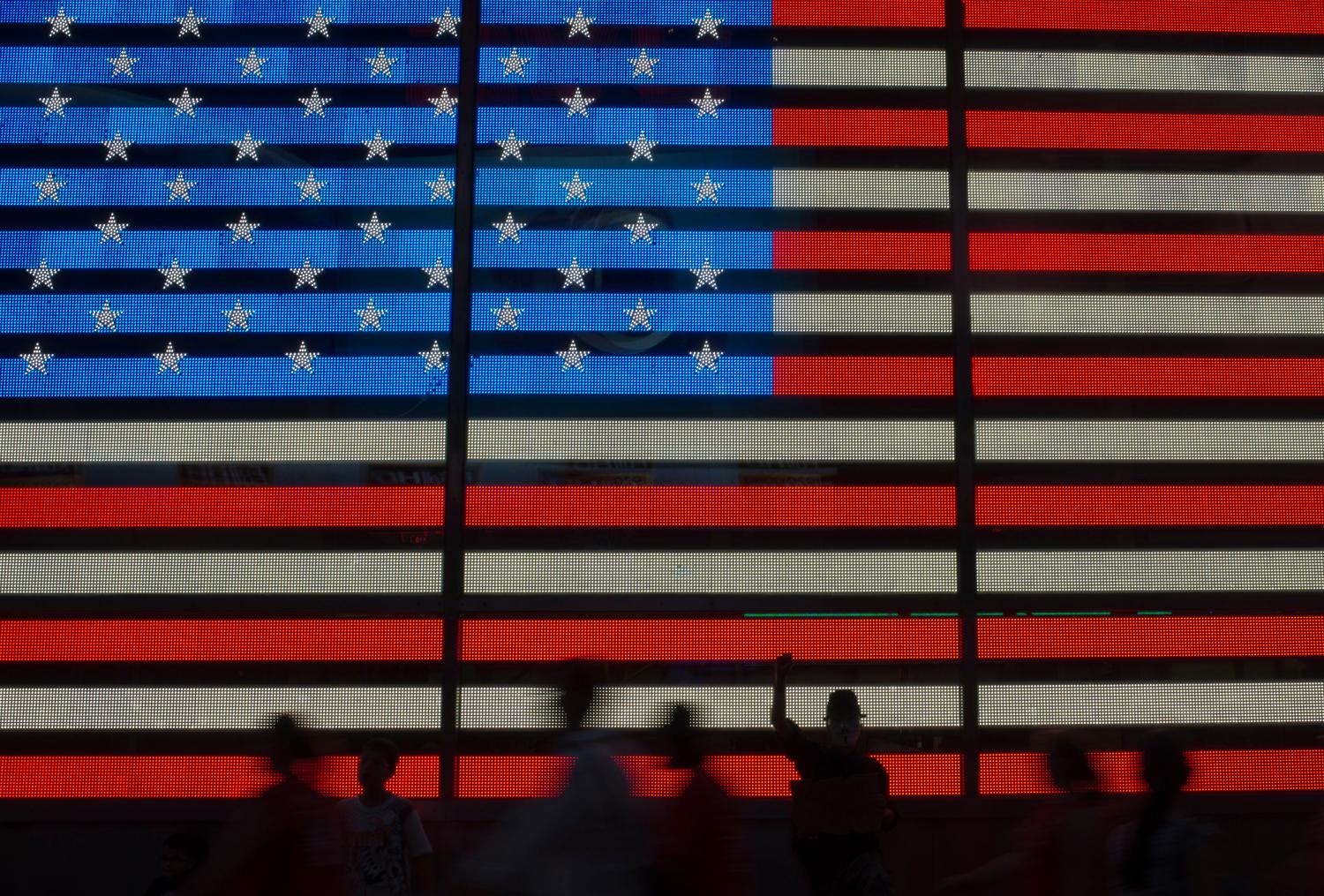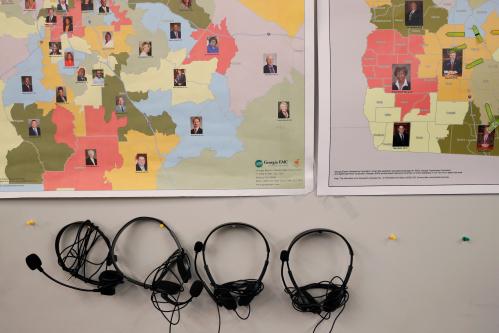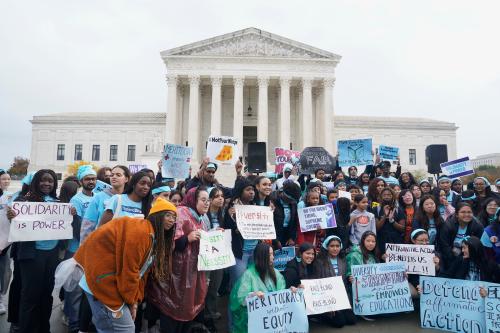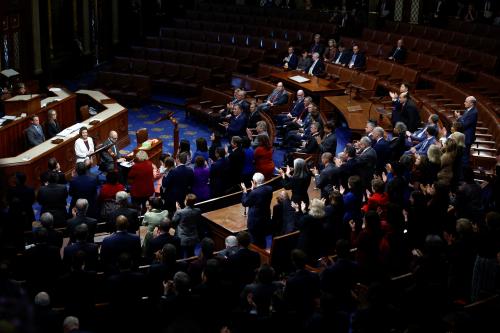This report is part of “A Blueprint for the Future of AI,” a series from the Brookings Institution that analyzes the new challenges and potential policy solutions introduced by artificial intelligence and other emerging technologies.
In the space of less than a decade, the world of social media has gone from being an enabler of to a threat to democracy. While the internet can still mobilize large numbers of people to political action, it can also spew false information about candidates, suppress the vote, and affect the voter rolls and the election machinery of the state. By 2016, social media had become a weapon against democracy as opposed to a tool for democracy. Unless we are vigilant, the new world of artificial intelligence (AI) has the potential to be an even more dangerous weapon in the years ahead. This paper will look at Russian interference in the 2016 election with an emphasis on intra-party disruption and then it will look at the ways in which AI can further disrupt democracy if we are not prepared.
The new technologies of the information age were heralded as invaluable instruments of democratic action because, in authoritarian countries, the regular media is under the control of the state, making the dissemination of negative information about the state and the publication of dissenting opinions all but impossible. When the “Arab Spring” began in Tunisia, it began with a group called Takriz that used new information technology to organize and eventually topple the country’s long-time president.1
In the space of a few short years, the technologies that once promised a way to break the tyranny of state-sponsored media and circumvent bans on political protests became the tools of those who would seek to undo democracy in America and throughout the Western world.
But in the space of a few short years, the technologies that once promised a way to break the tyranny of state-sponsored media and circumvent bans on political protests became the tools of those who would seek to undo democracy in America and throughout the Western world. The Russian assault on the 2016 American presidential election and on democracy was enormous and unprecedented—and it continues in 2018. Director of National Intelligence Dan Coats told the nation in July that “The warning lights are blinking red again,” a reference to the description of the intelligence climate prior to 9/11.2
The 2016 presidential election
The fact of Russian interference in the 2016 election is now well known in the United States. What is less well known is that the Russians have been at this in other countries; from elections in the Ukraine, to the Brexit vote in Great Britain, to Scotland, Austria, Belarus, Bulgaria, Czech Republic, France, Germany, Italy, Malta, Moldova, Montenegro, Netherlands, Norway and Spain.3
The purpose of Russian interference is deeper than simply attempting to move an election in a policy direction that would be preferable to Russia. After nearly two years of investigation we know that Russia’s goals are to destroy faith in democracy itself. They want to make citizens in democratic countries doubt the electoral system and they intervene in order to exacerbate a society’s differences by spreading malicious content. For instance, the assault on American democracy included not simply an assault on Hillary Clinton, the presidential candidate who, as a former Secretary of State had taken a tough stand toward Putin’s Russia, but it also included efforts to exacerbate the fault lines in American politics— especially race. Republican Sen. Charles E. Grassley (R-Iowa) had it exactly right when he said at a recent Judiciary Committee hearing, “Russia does not have loyalty to a political party in the United States. Their goal is to divide us and discredit our democracy.”4
In thinking about this threat, it is important to differentiate what is going on now from what has happened in the past. For instance, there is nothing new about election chicanery. The presidential election of 1800, a tough battle between President John Adams and Vice President Thomas Jefferson (they didn’t run on a ticket in those days) set the standard for decency pretty low. Adams’ campaign warned that if Jefferson was elected, “our wives and daughters would be the victims of legal prostitution,” and Jefferson’s campaign accused Adams of having a “hideous hermaphroditical character.”5
There is nothing new about election chicanery … [n]or is there anything new about foreign intervention in American political campaigns.
Nor is there anything new about foreign intervention in American political campaigns. In fact, the Founding Fathers were obsessed with the topic, which led to the inclusion of the emoluments clause in the Constitution. The world’s two superpowers at the time had definite preferences between the candidates. France preferred Jefferson’s party; England preferred Adams’ party.
In light of this well-documented history, Russian interference is not that unusual. Russia has had a distinct set of policy preferences centered on the lifting of sanctions imposed on them by the U.S. government after their takeover of Crimea. They have also had a long-time interest in weakening the NATO alliance and, through it, America’s role in the world. As Secretary of State, Hillary Clinton was one of the more hawkish members of the Obama Administration when it came to the “Russian reset.” Putin is known to hate her for her criticisms of the 2011 Russian elections and to blame her for instigating the demonstrations that followed them.6 Throw into the mix a heavy dose of misogyny on the part of Putin and his regime, and it is easy to understand why Putin did not want Hillary Clinton to become president.7
Russian attitudes toward Trump are also understandable. As far back as 1987, Trump took out full-page ads in three national newspapers, in which he argued for what would become the root of his “America First” foreign policy.8 The foreign policy pronouncements of a real estate developer would probably not normally draw the attention of a foreign government, but by 2015, Trump’s long shot candidacy had become far more realistic. As a candidate, Trump was as pleasing to the Russians as Hillary was disagreeable. On issue after issue, Trump diverged from long-standing American foreign policy consensus on issues that Russia cared about. While Trump had very little interest in the Republican Party platform being written in the summer of 2016, the one place his campaign intervened was to water down support for U.S. assistance to the Ukraine.
The 2016 election ushered in a new era in election meddling—an era dedicated not just to helping elect one party or the other, but an era dedicated to disrupting democracy itself.
It is one thing for a foreign power to want the outcome of an election to coincide with their policy preferences. It is another thing for a foreign power to try to undermine, sow distrust, and create confusion with regard to the very foundations of a nation. The 2016 election ushered in a new era in election meddling—an era dedicated not just to helping elect one party or the other, but an era dedicated to disrupting democracy itself.
Most attention has been paid to Russian efforts to help Donald Trump and the Republican Party. But there is another story that is just as, if not more disturbing: The fact that Russians also intervened in 2016 to suppress the vote amongst African-Americans and to alienate Bernie Sanders’ voters from Hillary Clinton.
Voter suppression as the malevolent use of soft power
In 2004, my colleague at Harvard and former dean, Joe Nye, wrote a famous book called “Soft Power.” So-called hard power is the power we are all familiar with—the epitome of which is military power. The United States has been the undisputed master of military power in the world for some decades now. But there are real limits to the use of hard power. Thus, as Nye defined it, there is another side of power—soft power, which is “getting others to want the outcomes that you want.” Soft power, according to Nye, “co-opts people rather than coerces them.”9 What the Russians accomplished in the 2016 presidential election was the malevolent use of soft power.
The right to vote, taken for granted by so many Americans, is, for African-Americans the result of a long and bloody struggle. They have been beaten and lynched for trying to vote. They have been subjected to a variety of impediments from poll taxes to literacy tests. In spite of passage of the 14th and 15th Amendments to the Constitution, in spite of the civil rights movement and passage of the Voting Rights Act of 1965, African-Americans still face challenges in exercising their right to vote. Some states have cut back on early voting, others have required a government-issued ID to vote. Still others have disenfranchised citizens for felony convictions. All of these restrictions hit the African-American population disproportionately.
In modern America, old-fashioned racism combines with partisan interests. Beginning with the Great Depression and accelerating into the civil rights movement, African-American voters moved out of the party of Lincoln and became the most loyal voting block in the Democratic Party. In each of the five presidential elections in the 21st century, African-Americans have given an average of 90 percent of their vote to the Democratic candidate for president—a pattern repeated in many other elections in the United States.10
Slavery, of course, has been called America’s original sin. And the Russians have been exploiting it as far back as the Cold War. “Covert influence campaigns don’t create divisions on the ground, they amplify divisions on the ground,” according to Michael Hayden, former director of the NSA and the CIA.11 Which is exactly what the Russians have done with regards to race relations in the United States for many years. In 2016, they used new technologies to suppress the African-American vote. While there are undoubtedly many contributing factors in addition to Russian interference, 2016 did see a significant decline in the black vote as the chart below, derived from Pew Research, indicates.
When we break turnout down by state, an even more interesting picture emerges. Black turnout decreased the most in two of the three states Hillary Clinton was supposed to win but lost by narrow margins: Michigan, where the drop-off in black turnout was a whopping 12.4 percent, and Wisconsin, where the drop-off was 12.3 percent. The other close state was Pennsylvania, where the drop-off was 2.1 percent.12 In Michigan and Wisconsin, the simple difference between the vote share won by Barack Obama in 2012 and the share won by Hillary Clinton in 2016 tells a dramatic story. The following table shows the raw votes for Clinton and Trump by state, the margin of victory that Trump won by, and the difference between Barack Obama’s vote in 2012 and Hillary Clinton’s vote in 2016 in key counties.
| State | Clinton vote – statewide | Trump vote – statewide | Trump margin of victory | Difference in Democratic vote for president in key counties between 2012 and 2016 |
| Michigan | 2,268,839 | 2,279,543 | 10,704 | Wayne County – 76,402 |
| Pennsylvania | 2,926,441 | 2,970,733 | 44,292 | Philadelphia County – 4,781 |
| Wisconsin | 1,382,536 | 1,405,284 | 22,748 | Milwaukee County – 43,616 |
| Source: Election results from Secretaries of State for Michigan, Pennsylvania, and Wisconsin. | ||||
As the above table indicates, the Democratic vote for president fell precipitously in two of the three key African-American counties in the states that Clinton lost narrowly. In Wayne County, home of Detroit, Obama got 595,846 votes in 2012 and Clinton got 519,444 votes in 2016 for a difference of 76,402 votes—seven times more than enough votes to have swung the state to Clinton had she performed as Obama had four years earlier. In Philadelphia, Obama got 588,806 votes in 2012 and Clinton got 584,025 in 2016 for a difference of 4,781 votes—not enough to have changed the outcome in the state. But in Milwaukee County, Obama got 332,438 votes in 2012 and Clinton got 288,822 (this is after the recount) for a difference of 43,616 votes—nearly twice what would have been needed to carry Wisconsin for Hillary.
The drop in the black vote is clearly consequential. As a Washington Post analysis showed, the 2016 Trump victory was not the result of an unprecedented vote by non-college educated whites. The full conclusion bears repeating here:
Among the six states that went for Obama in 2012 and Trump in 2016, only Florida saw a noticeable jump in white non-college-educated turnout, from 56 to 59 percent turnout. That, in tandem with significant drops in black and Hispanic turnout, helped Trump win there.
In Iowa, the non-college-educated white turnout dropped an estimated 8 points, to 57 percent, though it dropped only 2 points among white college graduates. Rather than a turnout boost, Trump won by winning a larger share of support among white voters overall than Mitt Romney.
The other states that flipped between the elections saw no meaningful change in white non-college-educated turnout. For many of them, what made the difference was the drop in black or Hispanic turnout. In Ohio, where Clinton lost by 8 points and Obama won by 3, black turnout dropped from 72 to 65 percent.13
So what happened in 2016? Of course, Hillary Clinton was not African-American like Barack Obama. Nor was she especially charismatic like Barack Obama. That certainly explains some of the drop-off in the black vote. But given the overt racism of the Trump campaign, one would expect better turnout numbers. After all, as the figure above illustrates, African-American turnout was increasing in 2000 and 2004, when two decidedly non-charismatic white men, Al Gore and John Kerry, topped the Democratic ticket. Russian intervention to suppress the vote thus becomes a likely suspect. Joel Benenson, Hillary’s pollster was stunned to find out from the Mueller indictment that the Russians had stolen his campaign’s internal modeling.14
According to the indictment, “The Russians allegedly masqueraded as African-American and Muslim activists to urge minority voters to abstain from voting in the 2016 election or to vote for a third-party candidate.”15 Chief among the fake African-American accounts were the “Blacktivist” accounts and the “Woke Blacks” accounts. The former purchased Instagram advertisements urging voters to “Choose peace and vote for Jill Stein. Trust me, It’s not a wasted vote.” And the “Woke Blacks” account told followers, “We’d surely be better off without voting AT ALL.”16 They also posted the following message: “A particular hype and hatred for Trump is misleading the people and forcing Blacks to vote Killary. We cannot resort to the lesser of two devils. Then we’d surely be better off without voting AT ALL.”17
The following chart is taken from the Mueller indictment of the Russian Internet Research Agency.18 Note that two of the advertisements are explicitly targeted at the African-American vote. This is most likely the tip of the iceberg of the Russian voter suppression campaign.
Another group targeted by the Russians, as documented by the Mueller indictment, were supporters of Bernie Sanders. According to the document, “They [Internet Research Agency] engaged in operations primarily intended to communicate derogatory information about Hillary Clinton, to denigrate other candidates such as Ted Cruz and Marco Rubio, and to support Bernie Sanders and then-candidate Donald Trump.”19 Specialists working for the Internet Research Agency were instructed to “use any opportunity to criticize Hillary and the rest (except Sanders and Trump – we support them.)”20 Among the many messages directed to Sanders’ voters were the following:
- Hillary has Parkinson’s disease
- Hillary is running a pedophile ring out of a pizza shop in Washington
- Anti-Hillary
- Hillary is sick
- Hillary is involved in Al Qaeda
- Hillary’s getting money from the Russians
- Hillary murdered her political opponents
- Hillary used a body double
- Hillary made a small fortune by arming ISIS
- Hillary gave the order to leave the four men in Benghazi
To their credit, there were several Sanders volunteers who served as web administrators for grassroots Sanders supporters. As they noticed suspicious activity, they tracked it back to foreign sources and often tried to warn their supporters—although their supporters didn’t always believe they were being played. Here are some who talked on the record to the HuffPost:21
- John Mattes, a web administrator for Bernie Sanders fans in San Diego noticed that people with no apparent ties to California were friending the page and posting links from anti-Hillary sites. He started tracing the emails and found 40 percent coming from Macedonia and Albania. Others were coming from Panama, from the U.S., or were untraceable.
- A Malibu-based volunteer administrator of half a dozen Sanders Facebook groups posted a memo in May 2016 warning of bogus sites. “The pattern I’m seeing is if a member is repeatedly posting articles that are only from one URL that person is just there to push advertising,” she wrote. “They probably have a sock account with little to no content. They are often from Russia or Macedonia.” (A “sock” or “sock puppet” account uses a false identity to deceive.) The administrator added, “Please share this with other Bernie groups so we can put an end to this spam bombing that’s filling up our pages and groups. It’s time to chase the mice out of the hen house and send them a message. They don’t know who they are messing with.”22
- Matthew Smollon, a web administrator from Knoxville, Tennessee, posted the following to his supporters in June, 2016, “Guys, I sincerely love you. I love your passion. I love your fire. I love all of that. But when 400 people are circle-jerking clickbait links in between wondering how Hillary Clinton is behind the FEMA Earthquake drill that happens on several days with one of them being primary day? Holy shit. You are allowing yourselves to be manipulated. Through the practice of taking anything that agrees with your opinion at face value, actively refusing to believe anything but what agrees with your narrative and following that up with blatant disregard for doing two minutes of searching to verify the information: you become the myopic Trump supporter that you so vocally loathe.”
- Bev Cowling, a Sanders web administrator from Toney, Alabama said, “It came in like a wave, like a tsunami. It was like a flood of misinformation.” She coined a phrase, ridiculosity, to describe the ridiculous misinformation being spread. But she got push-back from those who called her a “Hillbot.”
When the Mueller indictments came out, reporters sought out Bernie Sanders himself and his campaign manager Jeff Weaver to try to ascertain how much of this they knew. The Russian attack on Hillary began during the primary season. Sanders, an avowed Democratic Socialist substantially to the left of the Democratic Party, was only one of two candidates supported by the Russians. Sanders’s response to the Mueller report was to try and claim credit for having a staff member convey this information to the Clinton campaign. However, it turned out that the “staff member” was actually a volunteer, John Mattes, (cited above,) who did forward what he knew, but to a PAC associated with Hillary, not her campaign.23
The 2016 presidential campaign was the first but most certainly not the last example of malevolent soft power being used to influence a campaign, sow distrust in the democratic system and deepen fissures in society. All of that, however, pales in comparison to what the world of artificial intelligence could do to democratic systems and elections in the future.
Democracy in an AI world
The most straightforward description of artificial intelligence is machines that learn and can make decisions. Most people have heard about this in connection with things like driverless cars, where the car learns to take in data from other vehicles on the road and make decisions on how to cope with changes in weather or changes in road conditions. When applied to the actions of governments, many AI innovations are positive; for instance, who would not want faster and better emergency response systems?
When applied to the actions of governments, many AI innovations are positive; for instance, who would not want faster and better emergency response systems? But when the same technologies are applied to the messy world of politics, the potential for mischief equals or exceeds the potential for good.
But when the same technologies are applied to the messy world of politics, the potential for mischief equals or exceeds the potential for good. Campaigns are often discussed in terms otherwise used for warfare. For instance, there is the “ground war”—individual paid organizers and volunteers going door-to-door and talking to potential voters, and there is the “air war”—paid ads on television, radio, and the internet. Darrell West and John Allen have written, “In the end, warfare is a time competitive process, where the side able to decide the fastest and move most quickly to execution will generally prevail…[a] new term has been coined specifically to embrace the speed at which war will be waged: hyperwar.”24
Campaigns are also fast and competitive, especially at the end, when voters are more likely to tune in and when developments in the last days of the campaign can change the minds of a few, potentially critical, undecided voters. Last-minute news is thought to have played a role in two of our recent closely contested elections. In early November 2000, George W. Bush had to admit to an arrest for driving under the influence of alcohol when he was 30 years old. The news seems to have moved some last minute voters away from him, thus denying him a clean win and sending that election all the way to the Supreme Court. It also happened eleven days before the 2016 election, when FBI Director James Comey announced he was reopening the investigation into Hillary Clinton’s emails. Campaign officials saw a decided erosion in their vote. Campaign lore is filled with worries about an “October surprise.” New technologies make fake October surprises more likely and more dangerous.
In some future campaign, artificial intelligence will enable both sides to learn and adapt as they make decisions about how to engage the voter. Take, for instance the business of targeting where to send what messages. Discussed above is the fact that Russians stole targeting information from Hillary’s pollster Joel Benenson. Benenson had found that “The internal modeling showed that a high proportion of voters who should have been Hillary voters were considering voting for a third party candidate. In focus groups with voters in the fall of 2016, some consultants reported hearing some pretty crazy stuff, such as ‘I really hate Trump, but Hillary’s going to murder all these people.’”25 Knowing all we now know about the Russian use of malevolent soft power, it is possible that they had learned who these vulnerable voters were and were competing with the Clinton campaign for their votes.
In the hands of mere mortals, the problem posed by Hillary voters tempted by a third-party candidate was, at best, a two-step process: identify these voters and target a message back to them such as, “A third party vote is a vote for Donald Trump,” or “Don’t waste your vote.” The Russians, too, had to go through a two-step process and send out “Hillary is a killer” or “Vote for Jill Stein” messages.
But imagine a world where polling or search algorithms are attached to artificial intelligence and an automated or human voice on the end of the phone can learn the voter’s concerns and respond accordingly with “Don’t waste your vote,” or “Donald Trump will get rid of health insurance for pre-existing conditions.” All in real time. The potential exists to address the problem in one transaction. Think of this as high-frequency trading in political persuasion. The campaign hears your concerns and responds instantly with the proper persuasion—or the enemy (the other campaign or other power) hears the concern and magnifies it—all in one transaction. “Yes, Hillary is a crook. Did you know she made money selling arms to ISIS?”
Furthermore, AI allows for continual learning, so, as interactions with voters are completed, the machine can assess, depending on the voters’ response, how successful or persuasive the message was. Maybe “Hillary the killer” elicits skepticism, but how about “Hillary giving the order to leave four men behind in Benghazi who were eventually murdered?” Maybe that works better? AI will allow for the adaptation in real time.
The other AI development that poses real problems for democracy is the increasing ability of AI systems to put words into people’s mouths that they did not say. The benign application of this capability is to use face-recognition algorithms to put audio from a news clip into another language, something being worked on by professor Joon Son Chung at the Visual Geometry Group at University of Oxford. Also in the near term, the technology will improve video-conferencing, getting rid of the irritating lag that makes a video conference unpleasant to participate in or watch.
The process works by using face-recognition algorithms and an audio clip of the person speaking to manipulate the mouth so it looks like they are saying something they are not. So far, the technology focuses on changing the shape of the mouth, but changing an entire facial expression or posture is surely on the horizon. At this point in time, it is important to have large amounts of video of the person talking to enable this process. So, world leaders like Barack Obama or David Cameron are especially vulnerable to being featured in videos with fake words coming out of their mouths. But that will certainly change. Even in smaller-scale campaigns, it is common to have someone from the opposition videotape their opponent’s appearances, making it possible that a large amount of video is available for tricksters.
Of course, while AI can be used for dirty tricks; it can also be used to discover or even block dirty tricks. Here, the war analogy comes in handy again. The first-mover advantage, long familiar to those who have studied warfare, is important in this context. Whoever puts convincing, damaging words in the mouth of a candidate 48 hours before Election Day is likely to gain from it. Whether or not subsequent tricks work as well is another question.
What can be done?
A generational divide between digital “natives” and the older, non-natives that tend to be lawmakers, has meant that the expertise needed to regulate has simply not existed.
The problem AI poses to democracy is a subset of the problem posed by all modern technology in the information age: Government regulation, the typical response to societal challenges, is stymied by four factors. The first is the philosophy that somehow cyberspace, in all its manifestations, has been not exactly above the law, but rather beyond the law. As far back as 1996, at the World Economic Forum, the famous internet theorist John Perry Barlow made his “Declaration of the Independence of Cyberspace,” in which he claimed that law had no sovereignty in cyberspace. In the information economy, algorithms are law—traditional legal code is not. The second factor stems from the first—government regulation has come to be viewed as inimical to progress. Led by Ira Magaziner, the Clinton administration was the first presidency to tackle this problem. The result was a hands-off approach (pervasive today in the United States) that relies on civil society, contracts, and the marketplace to solve problems. Third, a generational divide between digital “natives” and the older, non-natives that tend to be lawmakers, has meant that the expertise needed to regulate has simply not existed. Finally, what goes on in cyberspace, especially in the realm of politics, runs right up against our deep tradition and respect for free speech. Darrel West shows that, around the world, attempts to deal with fake news have resulted in risks of censorship and a loss of freedom of speech. He writes, “Overly restrictive regulation of internet platforms in open societies sets a dangerous precedent and can encourage authoritarian regimes to continue and/or expand censorship.”26
This leaves us with a short and somewhat unsatisfactory list of options for what is to be done.
1) Government regulation
As noted above, this is difficult. For instance, Claire Finkelstein at the University of Pennsylvania has suggested that Congress “could require social media sites to engage in federal licensing for all foreign-source media accounts that seek to advertise or disseminate information above a certain monetary level of promotion.”27 But all talk of government regulation inevitably runs up against our very strong first amendment traditions around freedom of the press. In the example above, foreign media accounts would seek to adopt American “covers,” thus putting government regulators in the difficult position of uncovering who is foreign and who is American. During the 2016 election campaign, Americans sometimes even showed up at rallies as a result of ads placed by foreign actors. Clearly, those Americans were exercising their freedom of speech voluntarily even though the ads that prompted them to turnout were foreign.28
2) Strengthen political parties
Almost any mention of strengthening political parties, in any context, goes against today’s conventional wisdom. But political parties are the only institutions in America that have a long-term interest in contesting and winning elections —which is why they have a more moderating impact on candidates than special interest groups funded by “dark money.”29 Thus, political parties have to protect themselves against interference and take the lead in providing preventive and protective technology to state parties. This needs to happen on an ongoing basis. It’s the sort of basic house-keeping that cash-strapped and harried campaigns are unlikely to invest in.
3) Sanction campaigns that knowingly use or ignore tricks that are to their advantage
The best protection against foreign interference in our democracy has to come from those who are engaged on the front lines of the political process. Democratic and Republican operatives have to suppress the all-too-human desire to let negative stories spew out about their opponents. Because campaigns are fast-moving with a final end point, there is a temptation to let the ends justify the means.
The campaign people are the first to realize that something funny is going on. They are the ones likely to realize before anyone else that the candidate never said what she is being accused of, or that troubling messages are being sent to their targeted voters. Donna Brazile (a former DNC chair) and I (an At-Large member of the DNC) authored a resolution at the August 2018 Democratic National Committee meeting urging candidates to “inform the public of attacks on our electoral process as soon as possible and when such disclosures would not interfere with ongoing investigations.” We also ask campaigns to “be vigilant about assisting in efforts to monitor, identify and disclose such activity.”30 While law enforcement has a place in this process, widespread use of malevolent soft power (aka dirty tricks) will mean that law enforcement can’t keep up. By the time law enforcement gets in the act, the election may well be over. A new norm has to be developed and reinforced by the political parties that it is the candidates’ obligation to report campaign irregularities to the public as soon as possible.
Political parties can also explore even tougher sanctions. They can withhold party money from candidates who sit idly by and let negative information about their opponent go. Or, make it a criminal act to fail to publicly report dirty tricks during an election campaign.
4) Protect the vote
The most obvious way AI can wreak havoc on democracy is to break into the vote counting systems of a state and adjust the vote in ways that are difficult to ascertain.
Votes are customarily reported by precinct and by county and the voting behavior of most places does not change dramatically from one election to another. Thus, most people in politics and especially candidates have a very good idea where their votes are or should be—which is one reason why it is difficult to perpetrate large scale vote fraud.
But AI applications that learn and make subtle adjustments to vote totals as they come in will be very hard to detect. In the days when corrupt politicians would “vote the graveyard” it was often easy to see fraud. For instance, more votes would appear in a precinct than people who lived there. AI technology applied to the vote, on the other hand, would allow for small and subtle changes in the vote count as it came in—changes that would be nearly impossible to detect.
5) Keep real human beings in the system
The most devastating post-mortem of the failed Hillary Clinton campaign comes in the critique of Robby Mook, her campaign manager. He is described as a numbers guy—someone with little feel for politics and a strong belief in his algorithms. Others, from volunteers on the phone bank to older, experienced field operatives, repeatedly questioned the decisions driven by the algorithms.31
The absence of real human operatives on the ground talking to voters means that all sorts of things will go unseen. Imagine if the Clinton campaign had had a robust presence in Wayne County that was able to pick up the messages about Hillary and Trump being the same and able to counter them in real time with real people. As technology has progressed from radio to TV to the internet, findings about voters have been the same: they respond best to real people.
The second place where real human beings are invaluable is as detectors of fraudulent information. While computer scientists such as William Yang Wang have developed an algorithm that can identify stories based on fake information, others point out that nothing can really replace human evaluation. For instance, Steve Brill, an entrepreneur who first became famous as the creator of The American Lawyer magazine, argues that the bad guys will always find a way around the algorithm. He has started a company called NewsGuard, which employs former journalists to rate the veracity of the 4,500 sites that account for 98 percent of online engagement in the United States, in English.32 The journalists rate each site on nine dimensions and then give the site the equivalent of a “nutrition label.” For instance, one label applied to rt.com (Russia Today) reads, “Proceed with caution: This website generally fails to maintain basic standards of accuracy and accountability.”
6) Old-fashioned intelligence work
Disinformation has always existed, but it is now faster and harder to counter. The intelligence community has to use its old tools, such as human intelligence (HUMINT), and its new technological tools to focus on the IT sector, in order to keep track of and prevent serious interference in our democracy. Clearly, something like that was happening in 2016 or the special counsel’s office would not have been able to make the explicit indictments that it made. But the intelligence community has to devote the same level of resources to bad actors in the world of cyberspace that it has devoted to bad actors in the field of nuclear proliferation.
7) An educated public
Americans and citizens of other developed countries are very savvy when it comes to evaluating advertising for consumer products. When it comes to major purchases, they typically don’t run out and buy the product advertised by the sexiest blond. They use independent sources like Consumer Reports and check with friends and family. News literacy programs like the one that’s been developed at the Stony Brook University School of Journalism in New York help students recognize the differences “between fact and rumor, news and advertising, news and opinion and bias and fairness.”33 Some of this will happen naturally, as more and more news stories are exposed as fake. But investments in education like the programs at Stony Brook will go a long way toward developing a more discerning citizenry.
Conclusion
In short, dirty tricks and foreign intervention in American elections are not new. What is new is the ubiquity of the attack we witnessed on the 2016 presidential election—the exercise, by Russia, of malevolent soft power. AI only increases the number of ways in which the democratic system can be undermined. The first line of defense for our democracy are those who are involved in elections. They must take upon themselves the truth telling mantle—even if it means that they are giving up competitive ground. Ultimately, however, we need a citizenry equipped to make these judgments on their own.
-
Footnotes
- Rosen, Rebecca J. (2011, September 3). So, Was Facebook Responsible for the Arab Spring After All? The Atlantic. Retrieved from https://www.theatlantic.com. The Arab Spring spread to Libya, Egypt, Yemen, Syria and Bahrain. But the use of the internet received the most attention in Tunisia and Egypt.
- Nakashima, Ellen. (2018, July 17). NSA and Cyber Command to coordinate actions to counter Russian election interference in 2018 amid absence of White House guidance. The Washington Post. Retrieved from https://www.washingtonpost.com.
- Way, Lucan Ahmad and Casey, Adam. (2018, January 8). Russia has been meddling in foreign elections for decades. Has it made a difference? The Washington Post. Retrieved from https://www.washingtonpost.com; Casey, Adam; Way, Lucan Ahmad. (2017). Codebook – Russian Electoral Intervetions – 1991-2017. Retrieved from https://doi.org/10.5683/SP/BYRQQS.
- Kirchick, James. (2017, November 12). “How will Democrats cope if Putin starts playing dirty tricks for Bernie Sanders (again)? The Washington Post. Retrieved from https://www.washingtonpost.com.
- Ungar, Rick. (2012, August 20). The Dirtiest Presidential Campaign Ever? Not Even Close! Forbes. Retrieved from http://www.forbes.com.
- Crowley, Michael and Ioffe, Julia. (2016, July 25). Why Putin hates Hillary. Politico. Retrieved from https://www.politico.com.
- Johnson, Janet Elise. (2016, November 6). Putin’s Russia promotes both women and misogyny in politics. Wait, what? The Washington Post. Retrieved from https://www.washingtonpost.com.
- Unger, C. (2018). House Of Trump, House Of Putin. Dutton. p.51.
- Nye, J. S. (2004). Soft power: The means to success in world politics. New York: Public Affairs. p.5.
- Black Party Affiliation. (n.d.). Retrieved from http://blackdemographics.com/culture/black-politics/ and Tyson, Alec and Maniam, Shiva. (2016, November 9). Behind Trump’s victory: Divisions by race, gender, education. Pew Research Center. Retrieved from http://www.pewresearch.org/fact-tank.
- Ioffe, Julia. (2017, October 21). The History of Russian Involvement in America’s Race Wars. The Atlantic. Retrieved from https://www.theatlantic.com.
- Fraga, Bernard L. et al. (2017, May 8). Why did Trump win? More whites — and fewer blacks — actually voted. The Washington Post. Retrieved from https://www.washingtonpost.com.
- Mellnik, Ted et al. (2017, May 10). That big wave of less-educated white voters? It never happened. The Washington Post. Retrieved from https://www.washingtonpost.com.
- The internal modeling showed that a high proportion of voters who should have been Hillary voters were considering voting for a third party candidate. In focus groups with voters in the fall of 2016, some consultants reported hearing some pretty crazy stuff such as “I really hate Trump, but Hillary’s going to murder all these people.” Mayer, Jane. (2018, October 1). Russia Won. The New Yorker. p.24.
- Mosk, Matthew; Turner, Trish; Faulders, Katherine. (2018, February 18). Russian influence operation attempted to suppress black vote: Indictment. ABC News. Retrieved from https://abcnews.go.com.
- Ibid.
- Berman, Ari. (2018, February 16). Russians Tried to Suppress Minority Turnout, Spread Lies About Voter Fraud. Mother Jones. Retrieved from https://www.motherjones.com.
- United States of America v Internet Research Agency 1:18-cr-00032-DLF (D.D.C. 2018) p.20.
- Ibid, p.17.
- Ibid.
- Grim, Ryan and Cherkis, Jason. (2017, March 13). Bernie Sanders’ Campaign Faced a Fake News Tsunami. Where Did it Come From? Huffington Post. Retrieved from https://www.huffingtonpost.com.
- Despite initially being named in the HuffPost article, this volunteer subsequently asked that her name be removed from the piece because she said it painted an incomplete picture that focused only on Russians. https://www.salon.com/2017/03/31/fake-news-websites-targeted-trump-bernie-sanders-supporters-to-spread-conspiracy-theories/.
- Dovere, Edward-Isaac. (2018, February 24). Bernie Sanders promoted false story on reporting Russian trolls. Politico. Retrieved from https://www.politico.com.
- West, Darrell M. and Allen, John R. (2018, April 24). How artificial intelligence is transforming the world. The Brookings Institution. Retrieved from https://www.brookings.edu.
- Mayer, Jane. (2018, October 1). Russia Won. The New Yorker. p.24.
- West, Darrell M., (2017, December 18) How to combat fake news and disinformation. The Brookings Institution. Retrieved from https://www.brookings.edu.
- Stewart, Emily. (2018, February 19). Russian election inference is far from over. Vox. Retrieved from https://www.vox.com.
- Shane, Scott. (2018, February 18). How Unwitting Americans Encountered Russian Operatives Online. The New York Times. Retrieved from https://www.nytimes.com.
- La Raja, Raymond J., Rauch, Jonathan and Stoddard, Samuel VanSant. (2016, March 8). The state of state parties – and how strengthening them can improve our politics. The Brookings Institution. Retrieved from https://www.brookings.edu.
- Brazile, Donna and Kamarck, Elaine. (2018, September 17). Protecting democracy requires action from all of us. The Hill. Retrieved from https://thehill.com.
- Allen, J., & Parnes, A. (2018). Shattered: Inside Hillary Clinton’s doomed campaign.
- See: https://www.newsguardtech.com/.
- See: https://www.centerfornewsliteracy.org/.








